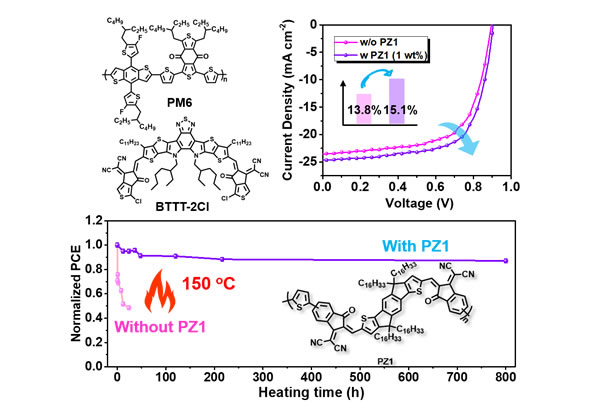New progress has been made in the research of thermal stability of organic solar cells in Wuhan University
Recently, the international journal Nature Communications (Nature · Communications) published the latest research results of the research team of the Institute of Advanced Studies on the stability of organic solar cells. The paper is entitled "Simultaneous enhanced efficiency and thermal stability in organic solar cells from a polymer acceptor additive ". This work demonstrates a simple and universal method that can simultaneously improve the efficiency and thermal stability of organic solar cells.
Yang Wenyan, a graduate student in the Min Jie research group, and Luo Zhenghui in the Yang Chuluo research group, are co-first authors, Min Jie is an independent corresponding author, and Wuhan University is the first completion unit. This work was supported by the National Natural Science Foundation of China and Wuhan University's independent research projects.
It is reported that organic solar cells (OSCs) have received much attention because of their advantages of light weight, strong flexibility, and rich colors. In particular, non-fullerene acceptor materials are widely used in the field of organic photovoltaics and increase the energy conversion efficiency (PCE) of OSCs to more than 17%. Basically meet the needs of commercialization. However, device stability studies are relatively few, far from meeting the requirements of commercial applications.
Generally, the actual operating temperature of the battery module outdoors is as high as 50 to 70 degrees Celsius; even in some areas, the operating temperature is as high as 100 degrees Celsius. It can be seen that heat is an important stress factor for the attenuation of OSCs, and the problem of thermal stability should be properly resolved. The thermal stability of multiple star photovoltaic systems has been significantly improved by introducing strategies to adjust the molecular structure, increase the glass transition temperature of the material, add crosslinking agents or compatibilizers, and introduce thermal cracking groups. However, these methods have the disadvantages of complex synthesis, poor repeatability, and low universality, which limit their wide application.
In this study, the author draws on the advantages of the third component material that can effectively reduce the interfacial free energy and inhibit the phase separation of the acceptor. The strategy of curing the interface area of ​​the acceptor through the intermolecular force selects a high molecular weight, long alkyl chain And the planar conjugated polymer acceptor material PZ1 increases the compatibility of the PM6: BTTT-2Cl photovoltaic system to the acceptor interface. The results show that by controlling the content of PZ1, the phase separation structure can be optimized, the crystallinity of the acceptor material can be increased, the carrier transport can be promoted, and the PCE of the PM6: BTTT-2Cl photovoltaic system can be increased from 13.80% to 15.10%. More importantly, PZ1 as a solid additive can significantly inhibit the aggregation of receptor molecules, solidify the microstructure of the blend, and improve thermal stability. After heating the undoped active layer at 150 ° C for 24 hours, the PCE decreased to half of the initial efficiency. In contrast, the PZ1-doped active layer lost only 12% of its efficiency after heating at 150 ° C for 800 hours. Furthermore, the PZ1-doped PM6: BTTT-2Cl photovoltaic system also exhibits good thermal stability under extreme thermal cycling conditions, indicating that it is suitable for outer space. In addition, the research of the other four photovoltaic systems shows that PZ1 is a "master key" that simultaneously improves the efficiency and thermal stability of the active layer.
In short, the author has developed a simple and universal doping strategy to improve the thermal stability of the photovoltaic system through the polymer acceptor PZ1 as a bifunctional additive. Moreover, the designed high-performance doped photovoltaic system has the potential for outdoor and space applications. Further research needs to design specific bifunctional additives for different types of photovoltaic systems, which will have important significance for the optimization and research of photovoltaic device efficiency and thermal stability. (Correspondent Min Jie)

PM6: BTTT-2Cl photovoltaic system and PZ1 additives and optimized device efficiency and thermal stability
Ultraviolet Lamp,Pll Uvc Tube,Pll Uvc Light,Pll Uvc Bulb
Changxing leboom lighting product CO.Ltd. , https://www.leboomuvs.com
